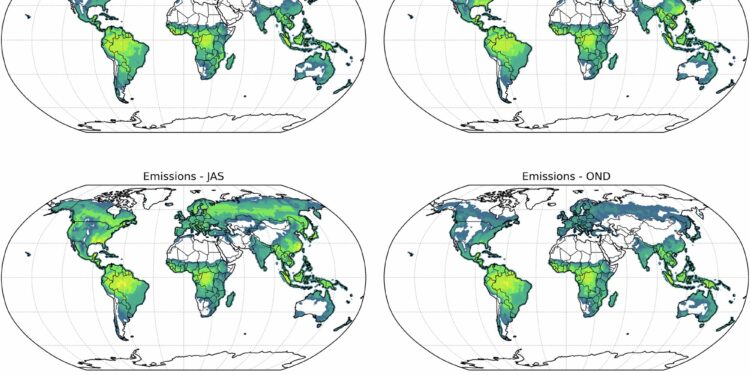Seasonal average emission rates of diterpenes (mg m−2 day−1) estimates for 2018 for execution “at scale”. Credit: Earth and Environment Communications (2025). DOI: 10.1038/s43247-025-02613-6
The compounds emitted by trees, diterpenes, could have a previously unconsidered impact on the formation of particles in the atmosphere.
The study carried out by the Institute of Environmental Diagnostics and Water Studies (IDAEA) of the Spanish National Research Council (CSIC) and the Institute for Atmosphere and Earth System Research (INAR) of the University of Helsinki is the first to quantify total diterpene emissions emitted by vegetation worldwide and their potential to form aerosols, representing a change in atmospheric patterns to this day. The results are published in Earth and Environment Communications.
Terpenes are naturally occurring volatile compounds emitted by plants and are essential for communication, pollination, and plant defense against herbivores. For example, they are responsible for the characteristic “forest scent” after rain or on a hot day. Once in the atmosphere, terpenes react with other compounds like ozone, giving rise to particles (also called aerosols). These aerosols affect air quality and respiratory health, reflect solar radiation and act as seeds for cloud droplets.
The reason diterpenes have not been considered in atmospheric models is that they are considered non-volatile due to their high molecular weight. However, thanks to more modern and more efficient analytical techniques, the scientific team has shown that diterpenes are indeed emitted into the air in appreciable quantities and can contribute to the formation of aerosols.
The results of laboratory experiments, using the diterpene kaurene, have shown that diterpenes can indeed be rapidly transformed into particles during reactions with ozone, with an efficiency of around 10%.
“This 10% efficiency means that a tenth of the mass of kaurene emitted into the atmosphere will form aerosols. Based on our previous chemical knowledge about the impact of molecular structures on aerosol formation, we expect that most other diterpenes can form aerosols with even higher efficiencies,” explains Mikael Ehn, professor at the University of Helsinki, who led the study’s laboratory experiments. The oxidation and aerosol formation potential of different terpenes has been a key focus of his research group at INAR over the past decade.
“This study represents a paradigm shift in our understanding of atmospheric composition, because until now diterpenes were not considered key elements in aerosol formation,” says Ana María Yáñez-Serrano, researcher at the Institute for Environmental Assessment and Water Research (IDAEA-CSIC) and first author of the study.
More information:
Ana Maria Yáñez-Serrano et al, Unaccounted impacts of diterpene emissions on atmospheric aerosol loads, Earth and Environment Communications (2025). DOI: 10.1038/s43247-025-02613-6
Provided by the University of Eastern Finland
Quote: Tree diterpenes form aerosols, leading to updates to atmospheric models (October 10, 2025) retrieved October 12, 2025 from
This document is subject to copyright. Except for fair use for private study or research purposes, no part may be reproduced without written permission. The content is provided for informational purposes only.



